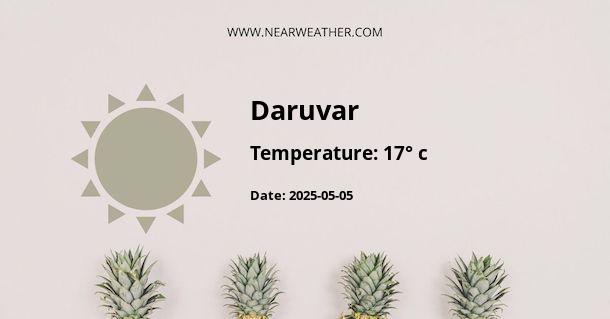Understanding the Climate and Weather Patterns of Daruvar, Croatia
Daruvar, a picturesque town in Croatia, boasts a rich history and serene landscapes that have enchanted visitors for centuries. Situated in the western part of the Slavonia region, just at the foothills of the Papuk Mountain, Daruvar’s climate is moderated by both its continental positioning and the gentle influence of its surrounding natural features. This guide provides a detailed overview of Daruvar's climate and weather patterns throughout the year, leveraging professional insights into meteorological data to help understand what makes this Croatian gem's weather unique.
The Climate of Daruvar
In meteorological terms, Daruvar experiences a humid continental climate, characterized by significant temperature variations between the seasons. Summers tend to be warm and sometimes hot, while winters can be quite cold, with snowfall a common occurrence. Precipitation is relatively evenly distributed throughout the year, although late spring and early summer might have heavier rain showers and thunderstorms.
Temperature Overview
Understanding the temperature swings on a month-to-month basis helps in planning visits and activities in Daruvar. The following information presents average high and low temperatures which can provide a closer look at what one can expect:
| Month | Average High (°C) | Average Low (°C) |
|---|---|---|
| January | 3 | -4 |
| February | 6 | -2 |
| March | 11 | 1 |
| April | 16 | 5 |
| May | 21 | 10 |
| June | 24 | 13 |
| July | 26 | 15 |
| August | 26 | 14 |
| September | 22 | 11 |
| October | 16 | 6 |
| November | 9 | 2 |
| December | 4 | -2 |
Please note that these values represent long-term averages and can be subject to variations due to changing climate patterns.
Precipitation Patterns
While Daruvar does not feature a specific dry season, certain months do experience more rainfall than others. The following chart provides an insight into average monthly precipitation values:
| Month | Average Precipitation (mm) |
|---|---|
| January | 35 |
| February | 30 |
| March | 40 |
| April | 50 |
| May | 60 |
| June | 70 |
| July | 60 |
| August | 60 |
| September | 55 |
| October | 45 |
| November | 50 |
| December | 45 |
Again, these figures are based on historical data and should be used as a general guide.
Seasonal Weather Highlights
- Spring (March - May): This season witnesses the awakening of Daruvar's natural beauty with flowers blooming and the landscape turning lush green. Rain showers are more frequent and temperatures rise gradually.
- Summer (June - August): Summers can be warm and ideal for exploring the town's outdoor activities, including visits to the nearby Papuk Nature Park. The area could experience occasional thunderstorms leading to cooler periods.
- Fall (September - November): Fall brings a colorful mosaic to the town's foliage. This season sees a gradual cooling with an increase in precipitation towards the end.
- Winter (December - February): The winter months can be cold, with snowfall adding to the picturesque setting, especially near the mountain areas. It is a great time for winter sports enthusiasts who enjoy skiing or snowboarding.
Weather Extremes and Records
In the realm of meteorology, Daruvar's weather, like any other region, is susceptible to anomalies and extremes. The town has experienced unusually harsh winters with heavy snowfall and record low temperatures, as well as periods of heatwaves during the summer months where temperatures have soared to record highs.
"Daruvar's climatic conditions can vary substantially from year to year, showcasing the unpredictability of weather patterns due to broader climate change influence," according to regional climatologists.
Sunlight and Daylight Variations
The geographic location of Daruvar means that there are significant variations in daylight throughout the year. The longest days occur in the summer months, particularly around the summer solstice in June, with the sun setting as late as 9 PM. Conversely, the shortest days are in December, around the winter solstice, with the sun setting before 4 PM.
"Daylight length can influence not only tourism activities but also the viticulture that the region is known for. For example, longer daylight hours during the growing season can be beneficial to local vineyards," experts in agricultural meteorology explain.
Wind Patterns and Conditions
Wind conditions in Daruvar are generally moderate throughout the year. However, stronger winds are possible during transitional seasons like spring and autumn when shifts between high and low-pressure systems are more common. Such winds can impact outdoor planning, especially for those interested in aerial sports or sailing on the region's lakes.
Climatic Considerations for Travelers and Residents
When considering a visit to Daruvar, it is advisable to pay attention to the expected seasonal norms. Visitors planning outdoor activities should particularly consider the likelihood of rain in late spring and the potential for heatwaves in the summer. Residents and local businesses should be aware of and prepared for the variable weather that each season brings—from ensuring proper insulation against the winter cold to preparing for potential summer storms.
Conclusion
To conclude, Daruvar's continental climate offers a diverse range of weather conditions suitable for various activities across different seasons. By understanding these patterns, both residents and visitors can better plan and enjoy all that this charming Croatian destination has to offer.
A - Daruvar's Latitude is 45.590561 & Longitude is 17.225000.
A - Weather in Daruvar is 2° today.
A - Climate Conditions in Daruvar shows snow today.
A - Humidity in Daruvar is 89% today.
A - Wind speed in Daruvar is 16.2 km/h, flowing at 356° wind direction. today.
